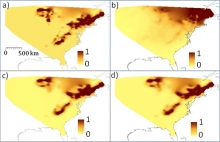You are here
New Research to Improve Climate and Species Models

Harvard Forest research recently published in Global Ecology and Biogeography will improve scientists' ability to map future range shifts for plants and animals in a changing climate.
A team including HF researchers Sydne Record and Aaron Ellison, former HF post-doctoral fellow Matthew Fitzpatrick, and HF graduate program alumnus Andrew Finley worked together to create new computer models for two groups of eastern forest trees, beech and hemlock. Their models were unique because they accounted for spatial autocorrelation--a concept that assumes locations that are closer together are likely to be more similar than locations that are further apart.
To see how well their models performed, the team projected them back 8,000 years and verified the output using the fossil pollen record. The models that accounted for spatial autocorrelation did indeed provide more accurate projections of the trees' actual distributions. The researchers suggest that the incorporation of spatial autocorrelation will help improve other models' projections for future range shifts of plants and animals.

